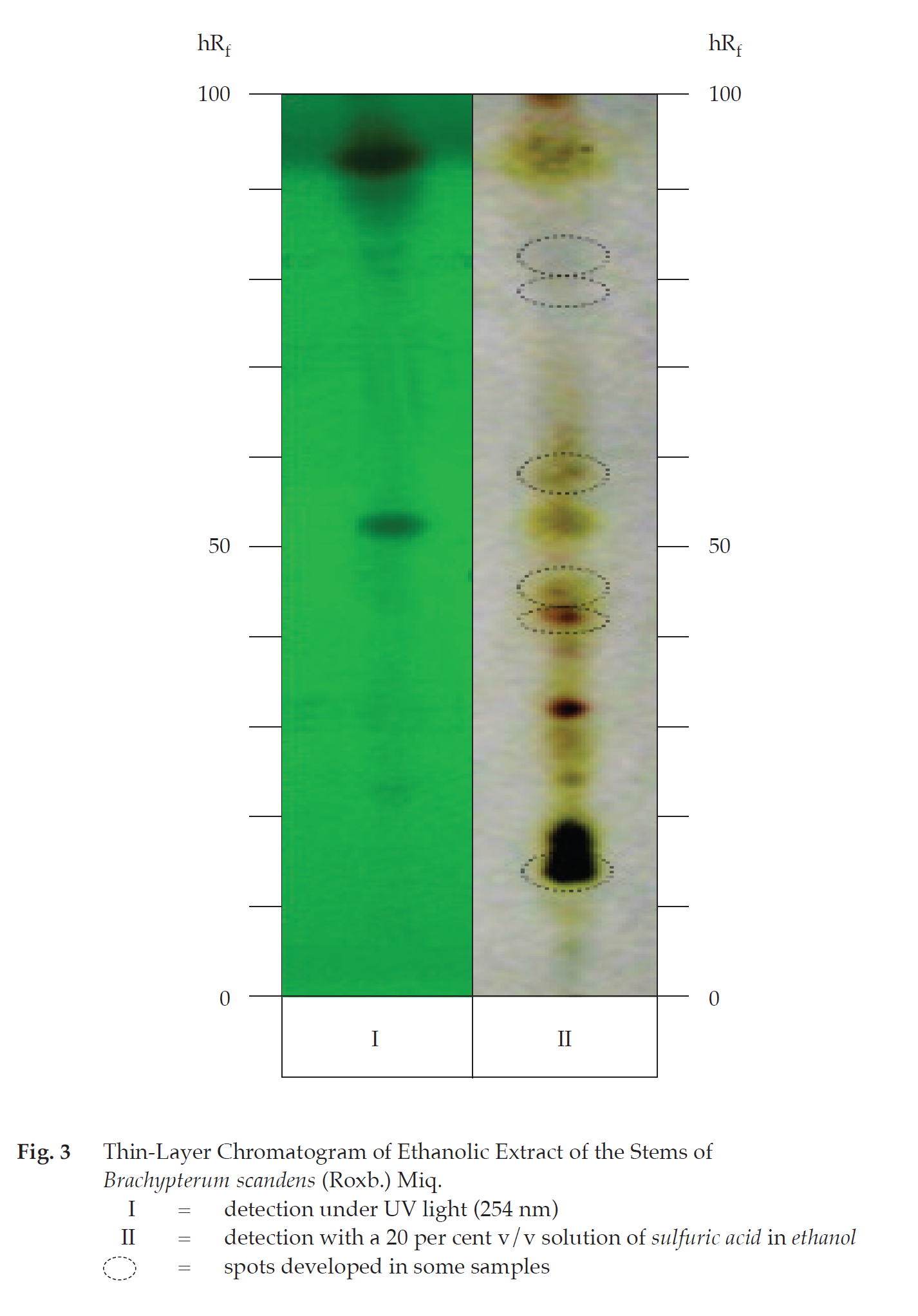ตำรามาตรฐานยาสมุนไพรไทย
Thai Herbal Pharmacopoeia
สำนักยาและวัตถุเสพติด กรมวิทยาศาสตร์การแพทย์ กระทรวงสาธารณสุข
Bureau of Drug and Narcotic, Department of Medical Sciences, Ministry of Public Health(Tinospora crispa (L.) Hook.f. & Thomson)
(Nelumbo nucifera Gaertn.)
(Centella asiatica (L.) Urb.)
(Centella Dry Extract)
(Centella Cream)
(Mesua ferrea L.)
(Piper sarmentosum Roxb.)
(Piper sarmentosum Roxb.)
(Pterocarpus santalinus L. f.)
(Santalum album L.)
(Senna tora (L.) Roxb.)
(Senna alata (L.) Roxb.)
(Senna Alata Tea)
(Piper retrofractum Vahl)
(Myristica fragrans Houtt)
(Andrographis paniculata (Burm. f.) Nees)
(Andrographis Capsules)
(Allium ascalonicum L.)
(Ocimum tenuiflorum L.)
(Curcuma longa L.)
(Turmeric Capsules)
(Turmeric Dry Extract)
(Turmeric Dry Extract Capsules)
(Arcangelisia flava (L.) Merr.)
(Curcuma sp.)
Harrisonia perforata (Blanco) Merr.
(Aristolochia pierrei Lecomte)
(Zingiber officinale Roscoe)
(Ginger Capsules)
(Ginger Tea)
(Cassia fistula L.)
(Nardostachys jatamansi (D. Don) DC.)
(Angelica sinensis (Oliv.) Diels)
Artemisia annua L.
(Ligusticum sinense Oliv. cv. Chuanxiong)
(Neopicrorhiza scrophulariiflora Pennell)
(Atractylodes lancea (Thunb.) DC.)
(Aucklandia lappa Decne)
(Terminalia chebula Retz.)
(Angelica dahurica (Hoffm.) Benth. & Hook. f. ex Franch. & Sav. var. dahurica)
(Kaempferia parviflora Wall. ex Baker)
(Hibiscus sabdariffa L.)
(Roselle Tea)
(Allium sativum L.)
(Zingiber zerumbet (L.) Sm.)
(Wurfbainia testacea (Ridl.) Škorničk.& A. D. Poulsen)
(Cannabis sativa L.)
(Myristica fragrans Houtt)
(Dracaena cochinchinensis (Lour.) S. C. Chen)
(Ficus racemosa L.)
(Hyptis suaveolens (L.) Poit.)
Clerodendrum indicum (L.) Kuntze
(Phyllanthus emblica L.)
(Citrus hystrix DC.)
(Citrus hystrix DC.)
(Areca catechu L.)
(Momordica charantia L.)
Moringa oleifera Lam.
(Aegle marmelos (L.) Corrêa)
(Solanum trilobatum L.)
(Morus alba L.)
Gynostemma pentaphyllum(Thunb.)
Makino
(Clinacanthus nutans (Burm. f.) Lindau)
(Cissus quadrangularis L.)
(Mimusops elengi L.)
(Zingiber montanum (J. König) Link. ex A. Dietr.)
(Piper betle L.)
(Capsicum annuum L.)
(Capsicum Oleoresin)
(Capsicum Gel)
(Piper nigrum L.)
(Piper nigrum L.)
(Eurycoma longifolia Jack)
(Thunbergia laurifolia Lindl.)
(Piper wallichii (Miq.) Hand.-Mazz.)
Senna garrettiana (Craib) H. S. Irwin & Barneby
(Terminalia bellirica (Gaertn.) Roxb.)
(Terminalia chebula Retz.)
(Caesalpinia bonduc (L.) H. Roxb.)
(Tarlmounia elliptica (DC.) H. Rob., S. C. Keeley, Skvaria & R. Chan)
(Hog Creeper Vine Dry Extract Capsiles)
(Hog Creeper Vine Dry Extract)
(Brachypterum scandens (Roxb.) Miq.)
(Lepidium sativum L.)
(Nigella sativa L.)
(Cuminum cyminum L.)
(Foeniculum vulgare Mill.)
(Plantago ovata Forssk.)
(Pimpinella anisum L.)
(Carum carvi L.)
(Anethum graveolens L.)
(Trachyspermum ammi (L.) Sprague)
Albizia procera (Roxb.) Benth.
(Acorus calamus L.)
(Tiliacora triandra (Colebr.) Diels)
Cyanthillium cinereum (L.) H. Rob.
(Orthosiphon aristatus (Blume) Miq.)
Murdannia loriformis (Hassk.) R. S. Rao & Kammathy
(Capparis micracantha DC.)
(Chrysopogon zizanioides (L.) Roberty)
(Cyperus rotundus L.)
(Cannabis sativa L.)
(Syzygium aromaticum (L.) Merr. & L. M. Perry)
(Boesenbergia rotunda (L.) Mansf.)
(Acanthus ebracteatus Vahl)
(Acanthus ilicifolius L.)
(Kaempferia galanga L.)
(Curcuma comosa Roxb.)
Betula alnoides Buch.-Ham. ex D. Don
Cannabis sativa L.
Carthamus tinctorius L
Mitragyna speciosa (Korth.) Havil
Mallotus repandus (Rottler) Müll. Arg
Azadirachta indica A. Juss. var. siamensis Valeton
Azadirachta indica A. Juss. var. siamensis Valeton
Punica granatum L.
Rhinacanthus nasutus (L.) Kurz
Baliospermum solanifolium (Burm.) Suresh
Curcuma aeruginosa Roxb
Boesenbergia kingii Mood & L. M. Prince
Senegalia rugata (Lam.) Britton & Rose
Acacia concinna (Willd.) DC.
Senegalia rugata (Lam.) Britton & Rose
Acacia concinna (Willd.) DC.
Senna alexandriana Mill. var. alexandriana
Cassia acutifolia Delile, Cassia angustifolia Vahl
Butea superba Roxb. ex Willd.
[Plaso superba (Roxb. ex Willd.) Kuntze, Rudolphia superba (Roxb. ex Willd.) Poir.
Pueraria candollei Graham
ex Benth. var. mirifica (Airy Shaw & Suvat.) Niyomdham
Streblus asper Lour.
Suregada multiflora (A. Juss.) Baill. (Gelonium
multiflorum A. Juss.
Plumbago zeylanica L.
Plumbago indica L.
Biancaea sappan (L.) Tod.
Ziziphus attopensis Pierre
Streblus asper Lour.
Justicia gendarussa Burm. f.
Enhalus acoroides (L. f.) Royle
Bridelia ovata Decne.
Tamarindus indica L.
Citrus × aurantiifolia (Christm.) Swingle
Garcinia mangostana L.
Blumea balsamifera (L.) DC
Persicaria odorata (Lour.) Soják
Zingiber montanum (J. König) Link ex A. Dietr.
Mammea siamensis (Miq.) T. Anderson
Citrus maxima (Burm.) Merr.
Citrus × aurantium L. ‘Som Sa’
Punica granatum L.
Rhinacanthus nasutus (L.) Kurz
Hog Creeper Vine is the dried stem of Brachypterum scandens (Roxb.) Miq. [B. scandens (Roxb.) Benth., Dalbergia scandens Roxb., Derris scandens (Roxb.) Benth., D. timoriensis (DC.) Pittier, Solori scandens (Roxb.) Sirich. & Adema] (Family Leguminosae), Crude Drug Number: DMSc 0438.
Constituents Hog Creeper Vine contains isoflavone glycosides such as genistein-7-O-[α-rhamnopyranosyl-(1→6)-β-glucopyranoside]. It also contains isoflavones (e.g., derrisisoflavones A-E, osajin, scandenone, scandinone and 5,7,4’-trihydroxy-6,3’- diprenylisoflavone), coumarins (e.g., scandenins A and B), sterols, etc.
Description of the plant (Figs. 1a, 1b) Large woody climber or scandent shrub up to 30 m long, up to 40 cm in diameter; branch finely pubescent then glabrous. Leaves imparipinnate, spirally arranged, 7 to 15 cm long; petiole 3 to 7 cm long; leaflets 7 to 13(‒19), oblong, obovate-oblong or elliptic, 2 to 9 cm long, 1 to 2.5(‒5) cm wide, apex obtuse to emarginate or acute, base cuneate or obtuse, margin entire, upper surface glabrous, lower surface pubescent; stipule small, caducous; petiolule short. Inflorescence raceme or racemose panicle, axillary, 8 to 45 cm long; pedicel 4 to 6.5 mm long. Flower papilionaceous, white to pale pink or purple; calyx cup-shaped, 3.5 mm long, purple, minutely dentate, silky pubescent; petals 5, much longer than the calyx, standard pink or whitish, with a greenish yellow basal blotch, obovate, 7 to 11 mm long, glabrous or pubescent on the lower surface, keel adhearing to the wings; stamens 10; ovary superior, 1-loculed, ovules (6‒)9 to 10 per locule. Fruit flat, lanceolate or oblong-lanceolate, 2.5 to 8 cm long, 1 to 2 cm wide, narrowed at both ends, with narrow wings along the dorsal suture. Seed(s) 1 to 5, reniform, dark brown.
Description Odour, mild; taste, bland.
Macroscopical (Fig. 1a) Dried full or fragmented pieces of obliquely sliced stems; bark yellowish to brownish, rough; sectional view lighter colour, yellowish brown, with few to several alternately light- and dark-coloured rings of vascular tissue, finely porous.
Microscopical (Figs. 2a, 2b) Transverse section of the stem shows cork layer, cortex, vascular tissue and pith. Cork, several layers of rectangular cells, some thick-walled, some containing prismatic crystals or reddish to brownish substances. Cortex, few layers of parenchyma cells, some containing simple and compound starch grains, groups of fibres and sclereids. Vascular tissue, anomalous type of phloem and xylem. Phloem, small thin-walled parenchyma cells, groups of fibres and phloem rays. Xylem consisting of younger xylem and older xylem. Younger xylem composed of large vessels, xylem parenchyma cells and xylem rays. Older xylem composed of small vessels, xylem parenchyma cells and small bands of xylem rays. Pith, round, thin-walled parenchyma cells, some containing brownish substances.
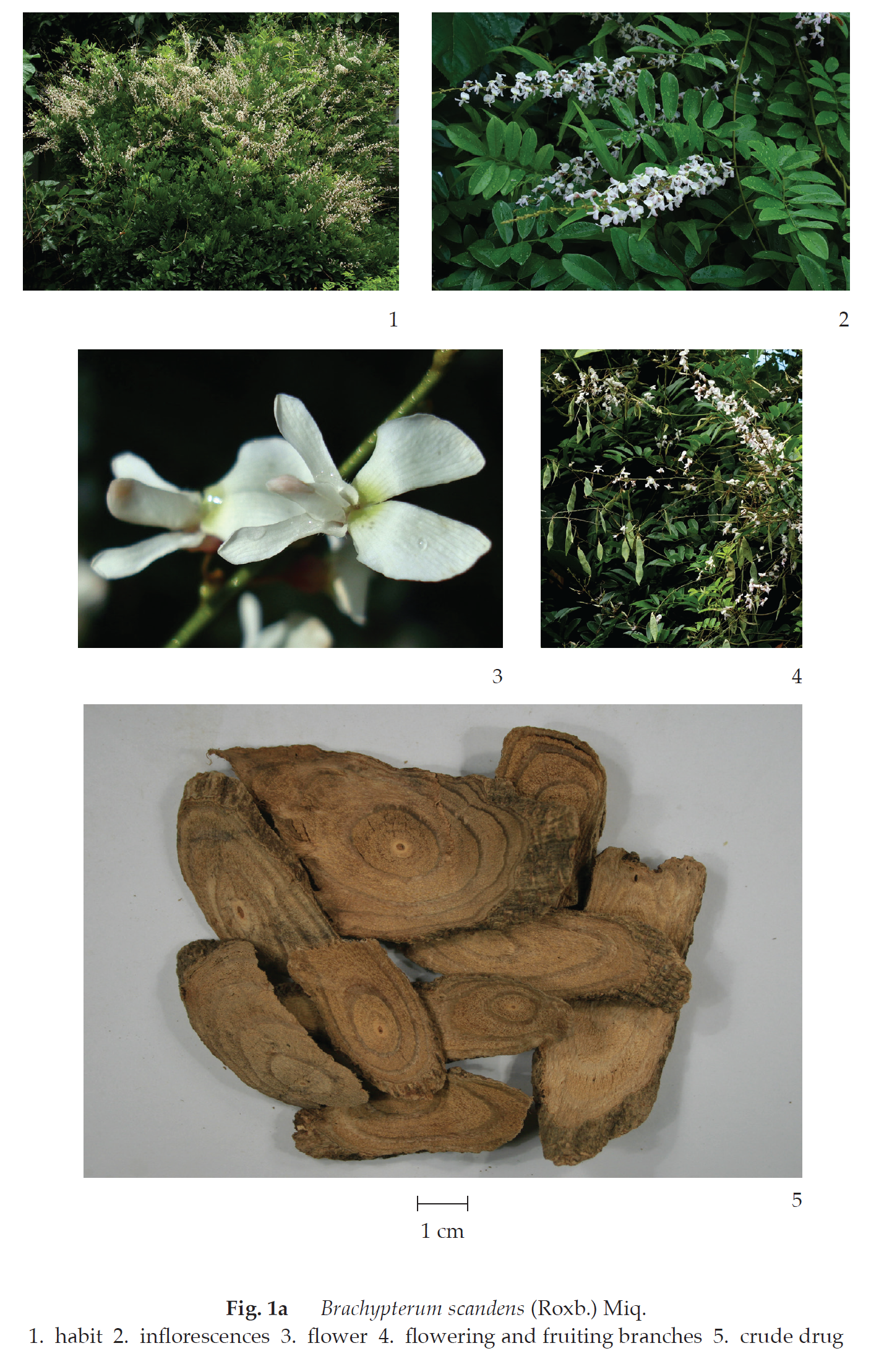
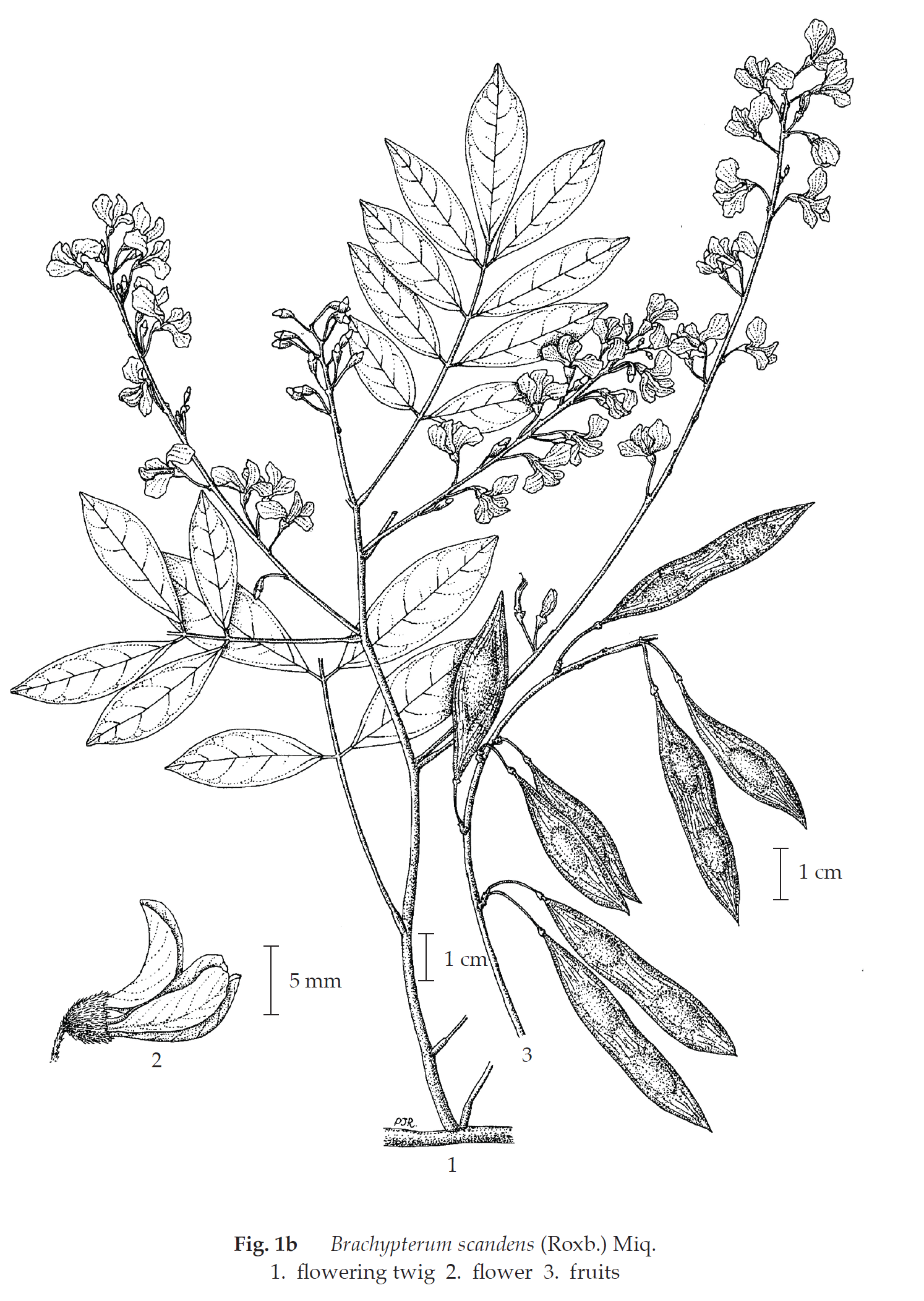
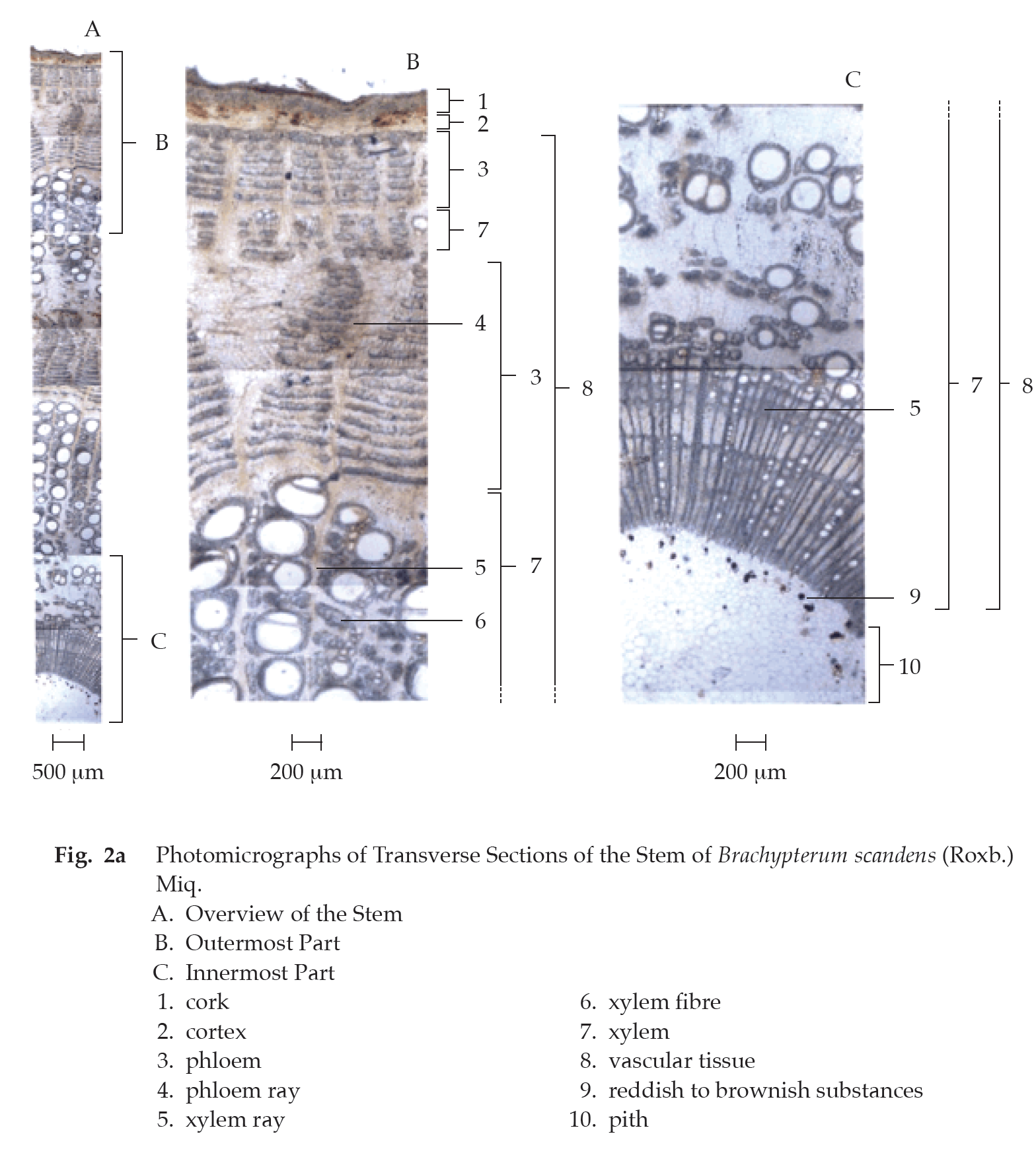
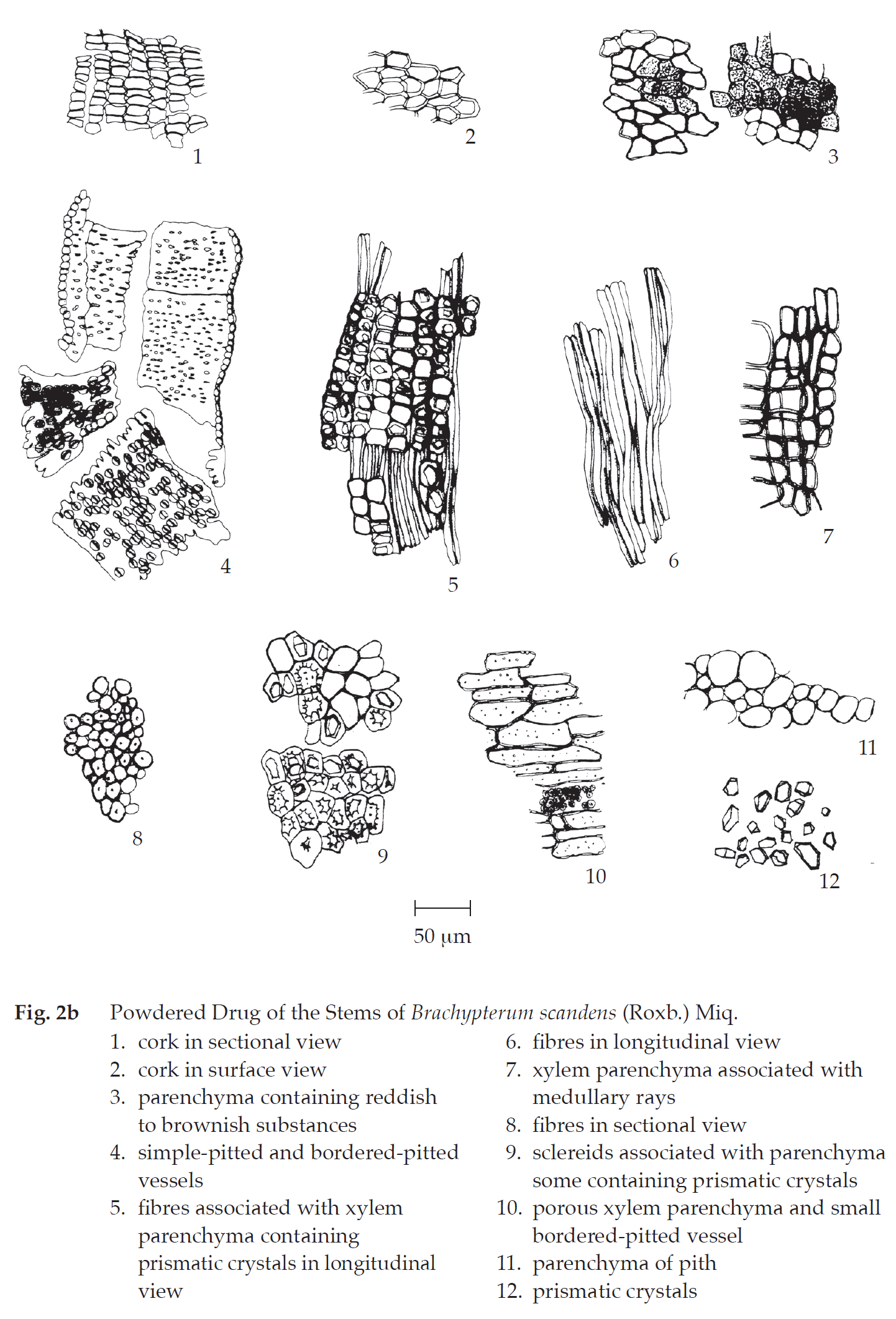
Hog Creeper Vine in powder possesses the diagnostic microscopical characters of the unground drug. Parenchyma with brownish substances, large bordered-pitted vessels, and numerous sclereids (some containing prismatic crystals) are characteristic.
Contra-indication It is contra-indicated in pregnant women.
Warning
1. It should be used with caution in patients with peptic ulcer.
2. It may cause gastro-intestinal irritation, stomachache, constipation, frequent urination, thirst, or palpitation.
3. Long-term use should be avoided.
Additional information It is commonly used with other herbal drugs in Thai traditional herbal preparations.
Packaging and storage Hog Creeper Vine shall be kept in well-closed containers, protected from light, and stored in a dry place.
Identification
A. Reflux 1 g of the sample, in fine powder, with 10 mL of methanol for 5 minutes and filter. Evaporate the filtrate to 1 mL, add 1 to 2 pieces of magnesium ribbon, shake well and mix with a few drops of hydrochloric acid. Warm in a water-bath: a reddish brown colour develops.
B. To 500 mg of the sample, in fine powder, in a tube with screw-capped add 10 mL of water and shake for a few minutes: a persisting foam is produced for over 15 minutes.
C. Carry out the test as described in the “Thin-Layer Chromatography” (Appendix 3.1), using silica gel GF254 as the coating substance and a mixture of 70 volumes of chloroform, 40 volumes of methanol and 10 volumes of water. Apply to the plate, 5 μL of the test solution prepared by refluxing 1 g of the sample, in fine powder, with 20 mL of ethanol on a water-bath for 20 minutes, filtering immediately, and evaporating the filtrate under reduced pressure at 50°. Dissolve the residue in 3 mLof ethanol. After removal of the plate, allow it to dry in air and examine under ultraviolet light (254 nm), marking the quenching spots. Spray the plate with a 20 per cent v/v solution of sulfuric acid in ethanol and heat at 105° for 5 minutes. Several spots of different colours are observed (Table 1); see also Fig. 3.
Table 1 hRf Values of Components in Ethanolic Extract of the Stems of Brachypterum scandens (Roxb.) Miq.
| Spot | hRf Value | Detection | |
| UV 254 | 20 Per Cent V/V Solution of Sulfuric Acid in Ethanol |
||
| 1 2 3 4 5 6 7 8 9 10 11 12 13 14 15 |
7-8 10-11 16-18 18-20 22-24 27-30 35-36 37-40 40-42 44-45 53-55 58-60 78-80 81-83 92-95 |
- - - - - - - - - - quenching - - - quenching |
pale brown pale brown dark brown dark yellow yellowish brown yellowish brown brown yellowish brown yellowish brown yellowish brown yellowish brown pale brown pale brown pale brown yellowish brown |
Loss on drying Not more than 7.0 per cent w/w after drying at 105° to constant weight (Appendix 4.15).
Foreign matter Not more than 2.0 per cent w/w (Appendix 7.2).
Total ash Not more than 8.0 per cent w/w (Appendix 7.7).
Ethanol (50 per cent)-soluble extractive Not less than 14.0 per cent w/w (Appendix 7.12).
Water-soluble extractive Not less than 14.0 per cent w/w (Appendix 7.12).
Dose 500 mg to 1 g three times a day after meals.
